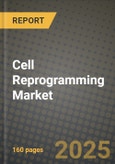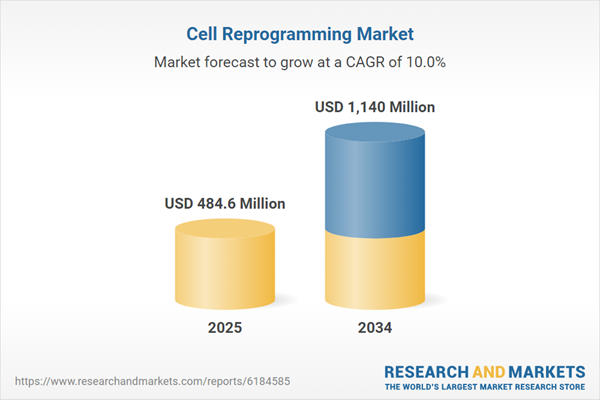Cell Reprogramming Market
The Cell Reprogramming Market spans technologies and workflows that convert somatic cells into alternative fates - induced pluripotent stem cells (iPSCs), directly converted lineage cells, rejuvenated or de-differentiated states - for R&D, disease modeling, drug discovery, toxicology, cell and gene therapy, and regenerative medicine manufacturing. The Cell Reprogramming Market is shaped by standardized, non-integrating delivery (mRNA, episomal, Sendai), high-efficiency factor cocktails, feeder-free/xeno-free media, and automated colony picking and expansion. Top end-uses include patient-specific iPSC banks, isogenic disease panels, neuronal/cardiac/hepatic differentiation for screening, off-the-shelf iPSC-derived cell therapies, and manufacturing enablers such as closed systems and QC analytics. Latest trends include hypoimmunogenic edits for universal donors, direct lineage reprogramming to bypass pluripotency, transient epigenetic rejuvenation, AI-assisted protocol optimization, and scalable bioprocessing in stirred-tank and microcarrier formats. Drivers are unmet needs in neurodegeneration and cardiac disease, rising adoption of human-relevant models over animal systems, venture and strategic funding into advanced therapies, and policy support for domestic biomanufacturing. The competitive landscape spans reagent and media suppliers, delivery-vector innovators, cell-engineering platforms, CDMOs, and therapy developers building vertically integrated pipelines. Execution risks include genomic integrity and tumorigenicity control, donor and IP licensing, CMC standardization, batch-to-batch variability, and workforce specialization across GMP. Overall, cell reprogramming is moving from bespoke lab art to industrialized, quality-managed platforms that feed discovery and power next-generation allogeneic and autologous therapeutics.Cell Reprogramming Market Key Insights
- Standardization of reprogramming inputs
- iPSCs as universal starting material
- Direct lineage conversion shortens timelines
- Hypoimmunogenic and gene-edited lines
- Automation and closed-system bioprocessing
- AI-assisted optimization
- Safety and genomic integrity governance
- Supply-chain and CMC playbooks
- Economics and platformization
- Regulatory and ethical alignment
Cell Reprogramming Market Reginal Analysis
North America
Deep academic-industry clusters, translational institutes, and venture funding drive rapid method standardization and scale-up. Hospitals and biotechs expand iPSC biobanks and allogeneic therapy programs, supported by CDMOs with closed-system platforms. Regulatory engagement emphasizes genomic integrity, comparability, and CMC rigor; workforce development and domestic supply chains are strategic priorities.Europe
Strong public research networks and ethical governance frameworks underpin large disease-specific iPSC repositories and advanced screening models. Emphasis on xeno-free, GMP-ready processes and documentation supports clinical translation. Cross-country collaboration and grants encourage standard protocols, while manufacturing hubs focus on automated expansion and release testing.Asia-Pacific
Significant government backing and fast-growing biomanufacturing ecosystems accelerate adoption in Japan, China, South Korea, Australia, and India. Clinical pilots explore iPSC-derived cell therapies, while contract manufacturers scale closed, automated workflows. Cost-competitive reagent production and local IP portfolios expand access; regulatory pathways mature alongside export ambitions.Middle East & Africa
Emerging programs link academic medical centers with global partners to establish stem-cell and iPSC capabilities. Investments target training, biobank setup, and core facilities with closed-system culture. Initial focus is on disease modeling and precision-medicine cohorts, with longer-term interest in allogeneic therapies as regulatory capacity develops.South & Central America
Regional centers build capacity for iPSC derivation and disease modeling tied to local health burdens. Partnerships with multinational suppliers and CDMOs support technology transfer, while cost-effective platforms and standardized SOPs enable gradual scaling. Regulatory alignment and workforce training are central to expanding from research to clinical-grade production.Cell Reprogramming Market Segmentation
By Technology
- Sendai Virus-based Reprogramming
- mRNA Reprogramming
- Episomal Reprogramming
- Others
By Application
- Research
- Therapeutic
By End-User
- Research & Academic Institutes
- Biotechnology & Pharmaceutical Companies
Key Market players
FUJIFILM Cellular Dynamics, ReproCELL, Takara Bio, Thermo Fisher Scientific, Lonza, STEMCELL Technologies, Miltenyi Biotec, Ncardia, BlueRock Therapeutics, Fate Therapeutics, Century Therapeutics, Sana Biotechnology, bit.bio, Mogrify, PluristyxCell Reprogramming Market Analytics
The report employs rigorous tools, including Porter’s Five Forces, value chain mapping, and scenario-based modelling, to assess supply-demand dynamics. Cross-sector influences from parent, derived, and substitute markets are evaluated to identify risks and opportunities. Trade and pricing analytics provide an up-to-date view of international flows, including leading exporters, importers, and regional price trends.Macroeconomic indicators, policy frameworks such as carbon pricing and energy security strategies, and evolving consumer behaviour are considered in forecasting scenarios. Recent deal flows, partnerships, and technology innovations are incorporated to assess their impact on future market performance.
Cell Reprogramming Market Competitive Intelligence
The competitive landscape is mapped through proprietary frameworks, profiling leading companies with details on business models, product portfolios, financial performance, and strategic initiatives. Key developments such as mergers & acquisitions, technology collaborations, investment inflows, and regional expansions are analyzed for their competitive impact. The report also identifies emerging players and innovative startups contributing to market disruption.Regional insights highlight the most promising investment destinations, regulatory landscapes, and evolving partnerships across energy and industrial corridors.
Countries Covered
- North America - Cell Reprogramming market data and outlook to 2034
- United States
- Canada
- Mexico
- Europe - Cell Reprogramming market data and outlook to 2034
- Germany
- United Kingdom
- France
- Italy
- Spain
- BeNeLux
- Russia
- Sweden
- Asia-Pacific - Cell Reprogramming market data and outlook to 2034
- China
- Japan
- India
- South Korea
- Australia
- Indonesia
- Malaysia
- Vietnam
- Middle East and Africa - Cell Reprogramming market data and outlook to 2034
- Saudi Arabia
- South Africa
- Iran
- UAE
- Egypt
- South and Central America - Cell Reprogramming market data and outlook to 2034
- Brazil
- Argentina
- Chile
- Peru
Research Methodology
This study combines primary inputs from industry experts across the Cell Reprogramming value chain with secondary data from associations, government publications, trade databases, and company disclosures. Proprietary modeling techniques, including data triangulation, statistical correlation, and scenario planning, are applied to deliver reliable market sizing and forecasting.Key Questions Addressed
- What is the current and forecast market size of the Cell Reprogramming industry at global, regional, and country levels?
- Which types, applications, and technologies present the highest growth potential?
- How are supply chains adapting to geopolitical and economic shocks?
- What role do policy frameworks, trade flows, and sustainability targets play in shaping demand?
- Who are the leading players, and how are their strategies evolving in the face of global uncertainty?
- Which regional “hotspots” and customer segments will outpace the market, and what go-to-market and partnership models best support entry and expansion?
- Where are the most investable opportunities - across technology roadmaps, sustainability-linked innovation, and M&A - and what is the best segment to invest over the next 3-5 years?
Your Key Takeaways from the Cell Reprogramming Market Report
- Global Cell Reprogramming market size and growth projections (CAGR), 2024-2034
- Impact of Russia-Ukraine, Israel-Palestine, and Hamas conflicts on Cell Reprogramming trade, costs, and supply chains
- Cell Reprogramming market size, share, and outlook across 5 regions and 27 countries, 2023-2034
- Cell Reprogramming market size, CAGR, and market share of key products, applications, and end-user verticals, 2023-2034
- Short- and long-term Cell Reprogramming market trends, drivers, restraints, and opportunities
- Porter’s Five Forces analysis, technological developments, and Cell Reprogramming supply chain analysis
- Cell Reprogramming trade analysis, Cell Reprogramming market price analysis, and Cell Reprogramming supply/demand dynamics
- Profiles of 5 leading companies - overview, key strategies, financials, and products
- Latest Cell Reprogramming market news and developments
Additional Support
With the purchase of this report, you will receive:- An updated PDF report and an MS Excel data workbook containing all market tables and figures for easy analysis.
- 7-day post-sale analyst support for clarifications and in-scope supplementary data, ensuring the deliverable aligns precisely with your requirements.
- Complimentary report update to incorporate the latest available data and the impact of recent market developments.
This product will be delivered within 1-3 business days.
Table of Contents
Companies Mentioned
- FUJIFILM Cellular Dynamics
- ReproCELL
- Takara Bio
- Thermo Fisher Scientific
- Lonza
- STEMCELL Technologies
- Miltenyi Biotec
- Ncardia
- BlueRock Therapeutics
- Fate Therapeutics
- Century Therapeutics
- Sana Biotechnology
- bit.bio
- Mogrify
- Pluristyx
Table Information
| Report Attribute | Details |
|---|---|
| No. of Pages | 160 |
| Published | November 2025 |
| Forecast Period | 2025 - 2034 |
| Estimated Market Value ( USD | $ 484.6 Million |
| Forecasted Market Value ( USD | $ 1140 Million |
| Compound Annual Growth Rate | 10.0% |
| Regions Covered | Global |
| No. of Companies Mentioned | 15 |









